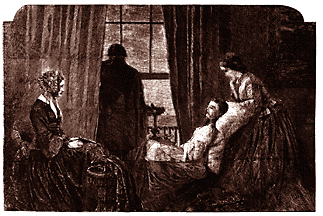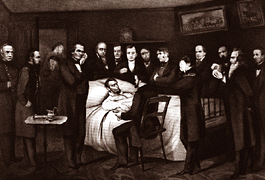
home
essays
 home essays |
Dan Meinwald
THE SITE OF DEATH
Death in nineteenth century America still retained elements of the medieval tradition. In this tradition, the setting for death was at home, in bed. As in any ritual, the appropriate procedures, and the roles of the participants, were predetermined. The principal role was that of the dying person. Those in secondary roles included not only the family, plus any doctors or clergy in attendance, but anyone else who wished to participate. The attention of everyone present was upon the central character, and the attention of that person was devoted, in turn, to those present. Each was called to the bedside, to be given advice, farewell, and blessing. All knew what to expect. A "good death" was one that progressed smoothly and embraced all of the elements that custom demanded. These had been codified by the fifteenth century, after the introduction of the printing press, in treatises on the art of dying, called ars moriendi, which contained both pictures and text for the benefit of literate and illiterate audiences..12

Though now abandoned, the traditional enactment and setting of death persisted into the twentieth century..13 As the dying scene of little Eva indicates--and this is merely one of a multitude of such scenes in European and American literature--the symbolic power of the deathbed, and all that was associated with it, was renewed and heightened in the nineteenth century. The principal difference was that death was no longer a public event but an extremely private one, restricted to the closest circles of the dying person. As the emotional focus of most people narrowed to the immediate family, the significance of the final act expanded.
Literature is by no means the only source of evidence for the importance of this event; references abound in the correspondence of ordinary people. An unattended death was viewed as a tragedy by the survivors. Attendance at the bedside was considered a privilege, and the inability to attend a great misfortune. For a relative unable to be present, descriptions of the occurrence were matters of intense interest. In one example from 1855, A.J. Hayter of Saline County, Missouri, wrote to his mother to learn the details of his father's death:
Mother i should have liked to have node whither he was resined to gow Joseph could not tell me exackly whither or not you must tell A to rite to me and let me now all about that gives me eas if he was perfectly resined to gow mother in that triing ower if he was prepared to gow what sweet thoughts to himself and all of his children.14A "good death" was not only a comfort to the onlookers, but a lesson in conduct and a potential source of inspiration. If a calm and harmonious passing gave rise to "sweet thoughts," a joyous death was an occasion for exultation. This can be seen in a 1838 letter from John and Rachel Ricketts of Franklin County, Indiana, to a brother, describing the death of their mother:
I feel gratified to inform you that she left the wourld in the triumfs of faith, in her dying moments Jesse and myself Sung a Cupple of favorite hyms and She Slapt her hands and shouted give glory to god and retained her senses while she had breath which gave us all a great deel of Satisfaction to See her happy. Such a great witness that she went happy out of the wourld..15There are very few photographs of deathbed scenes--that is, depictions of the dying rather than the already dead. Sickbed (rather than deathbed) scenes were sometimes recorded, but so rarely that it seems likely this was done only when the subjects were unable or unwilling to get out of bed. The resulting pictures do not convey any of the drama associated with a deathbed scene.
That scene, with all of its attendant emotional poignancy, was rendered in paintings, prints, and sculpture throughout the century..16 It is therefore not surprising that an attempt was occasionally made to re-enact the scene in a postmortem photograph. This was accomplished by showing the deceased subject in bed--or possibly on the parlor sofa--with one or more people in attendance. While these pictures lack the theatricality of artistic renderings, they do convey both a literal and a metaphoric impression that the dead person is still within the circle of the family.
It would have been difficult for a photographer to convey the drama of the deathbed scene as it was described in art and literature. It was possible, however, to stage such a scene for artistic purposes. This was done in at least one well-known instance. In 1858, the English photographer Henry Peach Robinson created Fading Away, which depicts a young girl near death, in the presence of her family. The picture was published in America, in a woodcut reproduction, within a year of its creation.
Quite aside from any aesthetic merit, Fading Away is of interest because of the criticism it received in its home country. (No record exists of its reception in the United States.) While it was known that the photograph had been stage-managed, objections were made because it was perceived to be an intrusion upon a private scene. To comprehend this, it must be noted that most postmortem photographs were meant to be viewed within the confines of the family. Renderings of the deathbed scene, in art if not in photography, were acceptable because they represented the pathos of the situation as a universal experience. When represented in a photograph, however, the same scene--and the same pathos--was perceived as specific to the family depicted. Thus the response to Fading Away, despite the fact that the "family" consisted of hired actors. The reaction to the picture is testimony to the emotional impact of the corresponding private pictures, no matter how prosaic they may appear by comparison.
The private nature of the deathbed scene was disregarded when a prominent person died. The death of a public figure was a public event, made so by the mass production of pictures of the final scene. The more prominent the person, the more likely it was that a deathbed scene would be recorded. These pictures are not photographic, since photographers were not given access to such events. It is probable, moreover, that photographs would not have satisfied public taste, even if they had been allowed; this was more readily accomplished through the medium of printmaking. In a print, an artist could not only create the required drama, but could alter the setting and other aspects of the scene to suit expectation.
The perceived need to do this resulted in the creation of formulas by which these scenes were depicted, and which were rarely varied except in minor detail. This can be easily demonstrated by comparing lithographs that depict the deaths of American Presidents. Each scene is essentially the same. The dying man is seen in his last moments, surrounded by members of his Cabinet and other people with whom he had been associated. It mattered little whether these people were actually present, or if they were, whether they were present at the same time. It was important, however, that their association with the dying man be maintained within the context of the print.
To cite just one example, a Currier & Ives lithograph of the death of President Lincoln, published in 1865, the year of his death, shows a spacious room filled with a crowd of people. The room in which Lincoln died, a bedroom in a boarding house across the street from Ford's Theatre, was very small. Although as many as ninety people were present in it during the course of the night-long vigil that took place after the shooting, only a handful could occupy the room at any given time.

The lithograph not only exaggerates this number, but depicts the presence of people who were never there--like Tad Lincoln, the President's youngest son, and Salmon P. Chase, the Chief Justice of the Supreme Court--or who were present only briefly, like Vice-President Andrew Johnson. Mrs. Lincoln is also in the picture, though she was not in attendance during her husband's final moments, and in fact had been kept away from the grisly scene as much as possible..17The formula followed in this picture, and many others like it, was far from new. In most respects it repeats medieval European depictions of the death of the Virgin Mary, who was invariably shown surrounded by Christ's disciples. The Deathbed of the Martyr President Lincoln is a secularized version of the same scene, with Cabinet members substituting for disciples. The opening of heaven, which is often depicted in conjunction with the death of the Virgin, is of course omitted. (The reception of Lincoln in heaven was depicted, however, in a widely-published photograph, made from an engraving, in which he is welcomed to the celestial region, not by Christ, but by George Washington.)
The deathbed scenes of public figures have a twofold character. By making the scenes public, the pictures return their subjects to one of the primary conditions of traditional death. On the other hand, they retain a principal condition of nineteenth century death, which is that it occurs within the family. The family, however, is tremendously extended, including not only the persons depicted but, by means of mass reproduction, thousands of vicarious viewers as well.